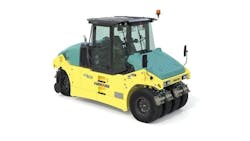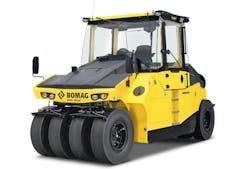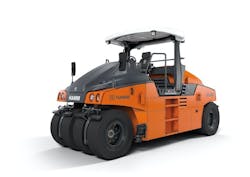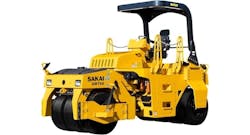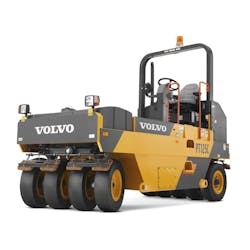The Best Pneumatic Rollers
Pneumatic-tire rollers may not be the most visible machine on the asphalt or soil compaction job site, but they are more versatile than one might think, and manufacturers continue to offer units with intriguing technology in areas such as ballasting, and tire pressure and temperature control.
Pneumatic-tire rollers can find utilization a number of ways on asphalt and soil.
Rubber-tire rollers can range from 5 to 30 tons in a variety sizes, weight categories, and tire sizes. They can be used to compact soils, hotmix, or other materials. They are adept at compacting asphalt around catch basins, water mains, or manhole covers.
The rubber tires knead material around and often provide better compaction than a steel drum roller.
Here’s a list of the best pneumatic rollers.
Ammann Pneumatic Roller
ART 280 Hydrostatic tired roller (above) features a redesigned cab and a ballasting system that can be quickly adjusted. The compactor also utilizes the Smart Machine Reset Traction System. Every time the compactor is started, the system automatically measures the machine’s weight and determines maximum speed and brake configurations for optimal safety. The company’s modular ballasting system enables the machine weight to be adjusted from 9 tons to 28 tons in a single hour with the help of only a forklift. This translates into a load-per-tire adjustment from 1.125 kg to 3.5 kg. The system enables use of varied ballasting materials including water, steel, concrete, and sand. The unit is designed for both asphalt and soil.
BOMAG Pneumatic Roller
The BW 28 RH features the company’s Ecomode setting, a triple-oscillating front axle, and a load limit control of the travel control system. A large ballast compartment is quickly interchangeable for steel and concrete weights, and a water ballast is optional. The three-way pivoting front axle ensures even weight distribution across all tires, the company says. Visibility to the outer tire edges allows compaction closer to the track edge. BOMAG Telematic provides location and operating data. Automatic reports provide full transparency on fuel consumption, idle times, and fleet optimization.
Case Pneumatic Roller
With an operating weight of 21,380 pounds (52,910 pounds at full ballast), a turbocharged 100-horsepower Deutz engine, and a compaction width of 78.2 inches, the PT240D is built for sub-base and asphalt compaction on large-scale road and highway projects, airport runways, and other large commercial developments. The tire configuration (four in front, four in back) with two-inch tire overlap kneads hot mix asphalt gently at the surface as it rolls across it. The result, the company says, is greater asphalt density and fewer possibilities for voids that can lead to flaws/deterioration. The roller is designed to handle up to 31,530 pounds of ballast, including steel, sand, and water. A large polyethylene water tank supplies a pressurized water feed system to prevent asphalt from sticking to the tires—and, at 103 gallons, allows operators to run for longer periods of time without refilling.
Caterpillar Pneumatic Roller
The CW16 pneumatic roller is available as a standard nine-wheel model with a 69-inch compaction width or as an optional 11-wheel model with an 84-inch compaction width. The unit is designed for work on highways, city streets, county roads, lane additions, industrial sites, overlays, or other mid-size jobs. Depending on ballast used (including water, sand, steel, or combinations), operating weight of the CW16 varies from an 11,464-pound base configuration to an approximate maximum weight of 33,000 pounds for the nine-wheel configuration and 32,850 pounds for the 11-wheel configuration. Operating weight can be adjusted to suit job requirements. Per-wheel weight can be varied from 1,280 pounds to 3,680 pounds for the nine-wheel model, and from 1,060 pounds to 2,975 pounds for the 11-wheel model.
Dynapac Pneumatic Roller
The medium-range CP1200 features two compaction widths, 69 inches and 82 inches, and the company’s Intelligent Flexible Ballasting concept, allowing steel, water, and sand ballast
weights from 12,200 pounds to 26,500 pounds. In addition, the optional “Air on the Run” feature lets operators inflate each tire to the exact pressure desired from the cab via an on-board air compressor. Tires are custom designed for asphalt applications, and individual spring-loaded tire scrapers and cocoa mats are made to ensure cleaner tires.
Hamm Pneumatic Roller
HP Series pneumatic-tire rollers have an upgraded operator’s platform, water-and-additive sprinkling system, and ballasting system. The series has a common platform for all model variants, including HP 180/HP 180i models with operating weights of 8 tons to a maximum of 18 tons; and HP 280/HP 280i models with operating weights between 10 and 28 tons. Operator’s platform provides visibility over the machine and the work site, and all models comply with the ISO 5006-2017 operator’s field of view standard. The HP Series has a minimal number of switches on the operator’s platform, and operator guidance is assisted by color-coded group- ings. Drive control is via joystick positioned on the armrest. The brake pedal is an integral part of the seat-operating unit, making the pedal accessible, irrespective of seat position.
Sakai Pneumatic Roller
The GW754 vibratory pneumatic-tire roller features include a 180-degree easy- rotating swivel seat, an increase in speed over its predecessor (to 7.5 mph), vibrators with four amplitudes that are changeable during use, and a Kubota Tier 4 110-horsepower engine. The unit has been proven to be effective in compacting hot mix asphalt, such as Superpave and SMA, the company says, and because the vibrating tires massage these mixes effectively, it densifies the pavement layer uniformly. The compact size and 20,440-pound weight outperforms a static pneumatic tire roller weighing 55,000 pounds, according to Sakai. Total rolling width is 77 inches.
Volvo Pneumatic Roller
The PT125C nine-wheel, pneumatic-tire compactor employs a kneading action for the compaction of hot and warm mix asphalt. The PT125C also is suitable for chip-seal applications, with the machine’s heavy-duty, 14-ply tires that press aggregate into binder without fracturing the stone. The unit is designed to be a good fit for applications using stiffer mixes, or as a complement to other compactors on jobs that require high density and smooth finish. Maximum operating weight of the machine can be adjusted from 9,830 to 25,000 pounds by ballasting with different materials. Variable ballasting, plus a central tire-inflation system, says Volvo, enables operators to meet the contact pressure desired on any job.
